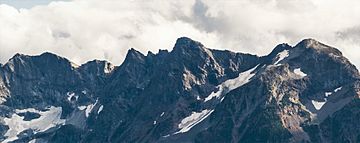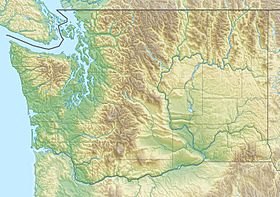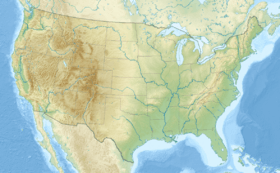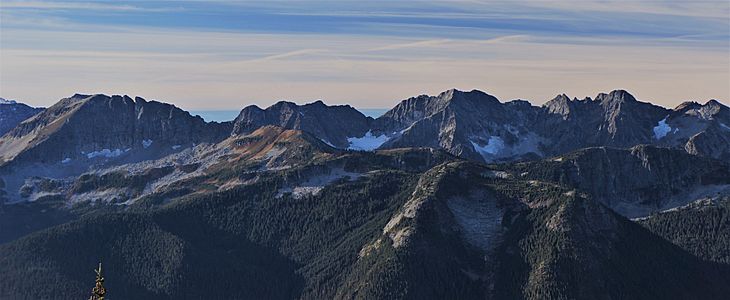Elija Ridge facts for kids
Quick facts for kids Elija Ridge |
|
|---|---|

Elija Ridge seen from Little Jack
|
|
| Highest point | |
| Elevation | 7,739 ft (2,359 m) |
| Prominence | 2,019 ft (615 m) |
| Isolation | 1.93 mi (3.11 km) |
| Parent peak | Gabriel Peak (7,940 ft) |
| Geography | |
| Location | North Cascades National Park Whatcom County, Washington, U.S. |
| Parent range | North Cascades Cascade Range |
| Topo map | USGS Crater Mountain |
| Climbing | |
| Easiest route | Scrambling |
Elija Ridge is a very noticeable mountain ridge in North Cascades National Park. It is located in Whatcom County, Washington state, in the United States. This ridge is about 7,739 feet (2,359 meters) tall. It is part of the North Cascades, which is a smaller part of the larger Cascade Range mountains.
The highest point on this ridge is called Elija Peak. Another peak on the ridge is named Ezekiel, which is 7,521 feet (2,292 meters) high. Elija Ridge is named after the prophet Elijah, linking to Tommy Rowland who settled nearby in 1895. Other nearby peaks like Gabriel Peak and Mount Prophet also share names connected to Rowland.
What is the Climate Like at Elija Ridge?
Elija Ridge is in a marine west coast climate zone. This means it gets a lot of moisture from the Pacific Ocean. This climate helps small glaciers form on the northern side of the ridge.
Most weather fronts come from the Pacific Ocean and move towards the Cascade Range. When these weather fronts hit the tall mountains, they are forced to rise. This causes them to drop their moisture as rain or snowfall onto the Cascades. This process is called Orographic lift.
Because of this, the western side of the North Cascades gets a lot of rain and snow, especially in winter. Winters are usually cloudy, but summers often have clear skies. The best time to visit or climb Elija Ridge is from July to September, when the weather is usually good.
How Did Elija Ridge Form?
The North Cascades mountains have very rugged land. They feature sharp peaks, long ridges, and deep valleys carved by glaciers. These amazing shapes were created by geological events that happened millions of years ago. These events also caused big changes in elevation, which led to different climates and types of plants in the area.
The Cascade Range started forming millions of years ago, during the late Eocene Epoch. At that time, the North American Plate was slowly moving over the Pacific Plate. This movement caused many volcanic eruptions.
Also, small pieces of the Earth's crust, called terranes, came together to form the North Cascades about 50 million years ago. These pieces were once part of the ocean floor or other continents.
During the Pleistocene period, which was over two million years ago, glaciers repeatedly moved across the land. As they moved, they scraped away rock and left behind rock debris. The "U"-shaped valleys you see today were carved by these glaciers. The combination of land being pushed up (orogeny) and cracks forming in the Earth's crust (faulting) along with glaciation created the tall peaks and deep valleys of the North Cascades.
Gallery
-
Elija Ridge (centered) north aspect, seen from Crater Mountain





